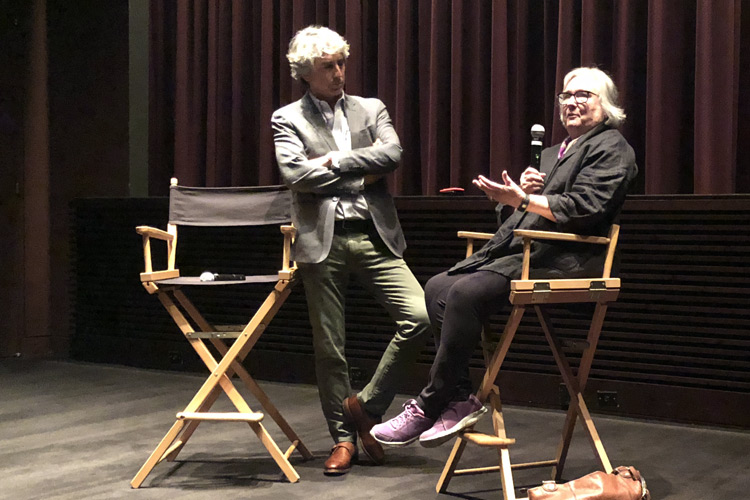The following questions and answers are excerpted from a conversation that followed the NBR screening of Downsizing.
Most of your films are connected to specific real-world locations. How did you approach this film where you created the place of Leisure Land?
Alexander Payne: Well it’s simply what the screenplay required. Jim Taylor, my co-writer, and I decided that early on we would allow our minds to run in all different sorts of directions. We found that the way to make this idea work was to have the small people live in in a segregated world. For small people, they would need to avoid too much radically different weather, so they’d probably be in New Mexico or the Southwest at least for these early communities. We also figured New Mexico would be the first place to legalize the downsizing procedure. In terms of directing, it’s probably because of the skills developed over previous films that I felt confident enough to attempt both the town and the workers sitting outside, living in those adapted construction trailers. I like to have a documentary approach to fiction because I want the places to feel real and the rhythms of the people living there to feel authentic. I also like to shoot with wide lenses in order to see everything. I don’t like to isolate characters with long lenses because I prefer to see the character in the environment.
“We also figured New Mexico would be the first place to legalize the downsizing procedure”
How did you conceive this story and develop the comedy for this film?
Payne: It’s maybe the funniest dreary movie of the year. People say that it ends on such a happy and optimistic note, but I don’t see that at all. It has the nice movie music at the end, but it’s fairly bleak. This film is disappointingly similar to other things I’ve done as a director with the guy from Omaha who has to figure out that he’s a lost, but well-intended, guy. He’s very Midwestern in that he accepts unhappiness with a smile.
What was it like bringing in visual effects to your work?
Payne: Visual effects have been around since the beginning of cinema and I thought, “well everyone else is doing it, so why can’t I?” Jim and I had this looney idea for a film and I had the confidence that we could make it because of the world we live it. This is a somewhat intimate story within a grand-scale required of those effects. There’s a lot of visual effects and my approach with the visual effects team was to have the effects be so believable as to be banal. I didn’t want them to be eye popping, I wanted them to be real. Another thing that was a challenge for the visual effects supervisors and ILM, our visual effects company, was that we ‘hang’ on the shots. In most other films using visual effects, each shot is quick and you can get away with shortcomings. With this, we stay on these shots for a long time. I think there’s around 750 visual effects shots, so it was expensive and tedious for the visual effects team.
How did you go about bringing together this diverse and well-rounded cast?
Payne: Matt Damon can do anything. He’s the only star of his age who I could believe as an everyman and I didn’t know of anyone else who could do this. Jorgan Asbjørnsen is played by the great Rolf Lassgård. You may remember him from last year’s A Man Called Ove and I looked in Norway, but couldn’t find the right guy. A Norwegian producer told me to call up Stockholm and get Rolf, who is the greatest actor in Scandinavia. He couldn’t be a nicer or more brilliant actor. We got the great Hong Chau to play Ngoc Lan Tran as I was hurling the casting net to Vietnam, Canada, France, Australia, and anywhere that there may be a pocket of Vietnamese people. She was living three miles from Paramount Studios with her husband and dog. She auditioned and just understood the script, comedy, and pathos immediately.
What are some of the biggest evolutions and changes that you’ve made to this story after working on it with a co-writer for more than a decade?
Payne: I had intended this to be my first film after Sideways, which came out in late 2004. I was delayed because the screenplay took so long to write and then it was difficult to find financing. For the screenplay, we had this idea, but we had to find a story to encapsulate it and do the idea justice. It’s a big enough idea where it could have been a series or a mini-series, so the challenge was to get it into a manageable two-hour movie. We didn’t plan the story as we writing and just let our imaginations run wild, thinking that we’d go back later and clean it up. That’s why it goes in such weird directions. Essentially what changed over the years is that we made it shorter. Even for Hong Chau’s character, we had thirty pages just on her character that we had to cut.

